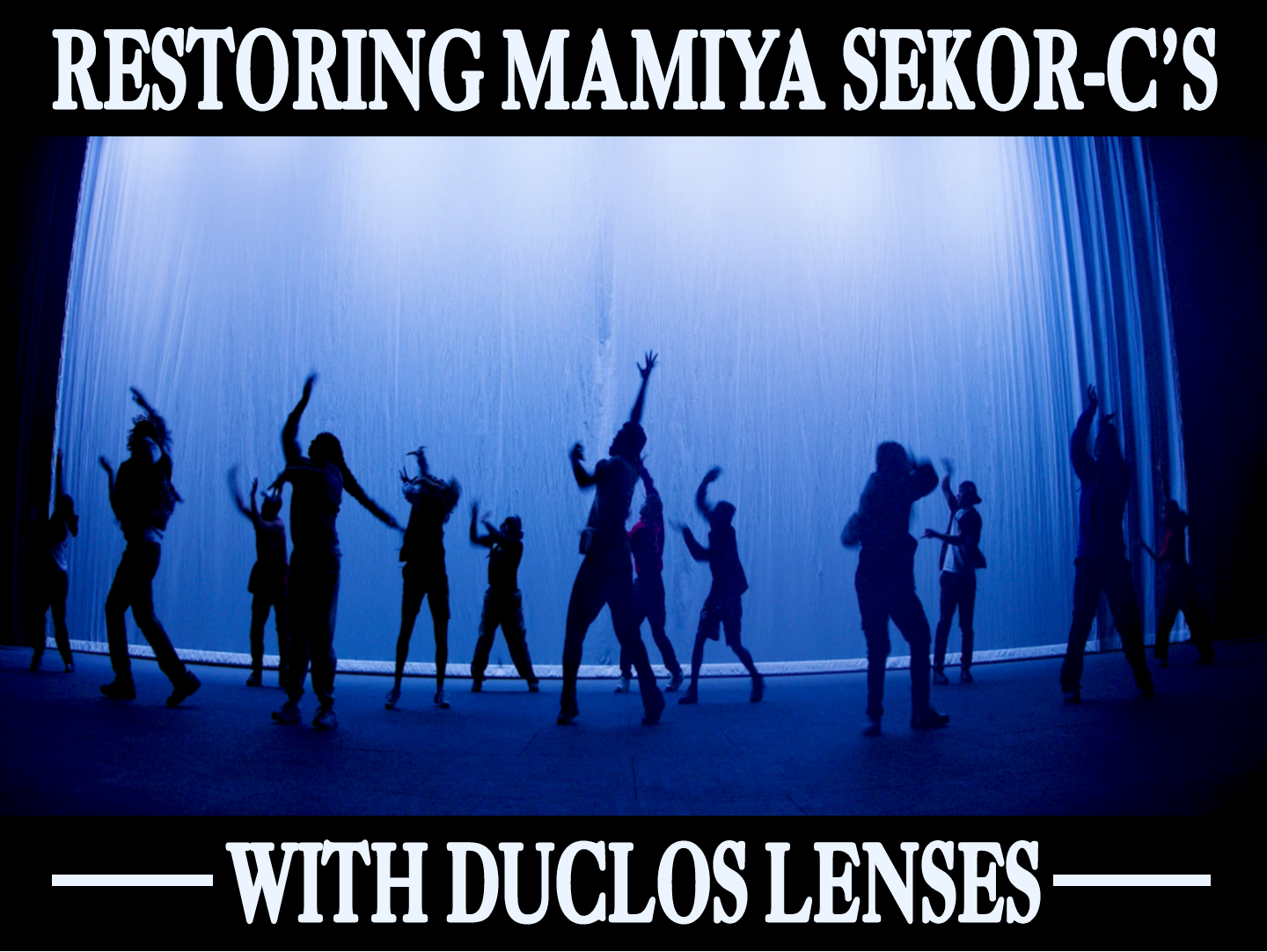Special thanks to Pogi Studios for the media used throughout this piece.

Mamiya Sekor-C lenses | Camera Ambassador
The Mamiya Sekor-C lenses first launched with the Mamiya 645 camera system in the mid-1970s to the mid-1980s. The lenses were originally intended for a medium format camera, producing a picture size of 6 by 4.5 cm (hence the name 645).
With the advent of larger sensor sizes on cinema cameras, however, medium-format lenses such as the Mamiya Sekor-C are seeing a huge uptick in popularity. Camera Ambassador Founder and CEO Erica Duffy is always on the lookout in the used market for a diamond in the rough. So, when these lenses popped up on her radar, she knew that she had to have them.

“I’m always looking for vintage lenses that can give our clients’ projects a unique look,” Erica says.
Yet, when the lenses came in, there was still work to be done. The photography lenses were built for the original Mamiya 645 camera and couldn't be mounted on any of the cinema cameras. Furthermore, the lenses had issues, such as heavy focus and fungus.
So, Camera Ambassador called in the experts.

Matthew Duclos (pictured here) at Tiffen Technical Center | Duclos Lenses Facebook

Matthew Duclos has been fascinated by lens service and maintenance ever since he was 13 years old. He inherited his passion for glass from his father, who was the Head of the Lens Department at Clairmont Camera. After an apprenticeship with Kish Optics and work at Keslow Camera, Matthew went on to join his sister and father as Co-Founder and COO of Duclos Lenses.
As Matthew says time and time again: “Lenses are my life”.
“There are two paths for any lens that comes into our shop. It's either here for service or modification,” Matthew explains, “and in either path, the first step after they've actually been received physically is to be evaluated by a technician.”
When Camera Ambassador's Mamiya Sekor-C’s arrived at Duclos Lenses, they were immediately assessed right off the bat, which was especially helpful since it was carefully done by the best. An accurate diagnosis was critical, as pre-existing issues would remain problematic even after the Cine-Mod™ process. Furthermore, some complications could even compound and cause damage over time, like the fungus found on a couple of the lenses. Since fungus is an organic contaminant, it can actually etch itself through the coatings into the glass if left on it’s own long-term.
“Then, the only solution is to polish the glass and hope it hasn't etched itself too far into the actual glass itself,” Matthew notes.

Converting the Mamiya Sekor-C Lenses mount to PL mount | Duclos Lenses
Luckily, Duclos had caught the fungus on Camera Ambassador's lenses early on and was able to fully treat them. The Mamiya Sekor-C primes then entered the Duclos’s official Cine-Mod™ process. One of the lens technicians, Evan Matteson, then de-clicked the aperture ring for smooth iris adjustments, converted the mount from the pre-existing 645 mount to a PL mount, and added in a Seamless 32-pitch focus gear for matte box compatibility.
Not all older lenses can be repurposed like the Mamiya Sekor-C's, though.
“In some lenses, you’re basically changing this very delicate shutter system, which can be challenging,” Matthew clarifies, “but unlike most medium format lenses, the Mamiya Sekor-C lenses doesn’t have an internal shutter in the lens itself, which lets us de-click the aperture ring with more ease.”
Furthermore, older lenses such as the Mamiya Sekor-C lenses were made to be serviceable and long-lasting. When auto-focus lenses grew in popularity, parts became really cheap. So, manual focus vintage lenses, although older, generally remain superior to auto-focus lenses in build quality.
“If the Mamiya Sekor-C lenses were cared for,” Matthew says, “then they're going to work just as well today as they did back 30-some odd years ago.”

Bryan Wright (pictured here) filming with the Mamiya PL Sekor C f/3.5 Lens | Pogi Studios
With the rise in larger sensors, it’s no surprise that there’s a growing demand for these vintage still lenses.
“People are starting to realize that these lenses are really good,” Matthew comments, “and prices are starting to skyrocket.”
Matthew then talks about how Cine-Mod™ is surging in popularity as cinematographers begin to realize that a vintage still lens can still produce a beautiful image. He lists the famous Canon K35 lenses as an example [used in productions such as Aliens (1986) and American Hustle (2013)], which are traditionally cinema lenses. On the other hand, older Canon FD mount lenses were used as photography lenses. Although the Canon K35 lenses and Canon FD lenses may seem to be completely different, in fact, cinematographers later learned that the Canon K35 lenses were simply re-housed FD lens-glass done by Canon.

"So filmmakers realized that they can get glass in a smaller, cheaper, lighter housing in these vintage lenses, and then just do something like our Cine-Mod™," Matthew explains, "then, they have the budget version of that same high-quality lenses that were used to make some of the most highly beloved motion pictures of the 80s/90s."



"The Mamiya lenses provide a great look that can be used in a variety of situations. The lens flares, skin tones, and soft bokeh provide a cinematic quality that 'cleaner' lenses lack." -Bryan Wright, DoP, on using the lenses for Personal Legends, a docu-series by Pogi Studios | Pogi Studios
When asked how cinematographers can best utilize these Mamiya Sekor-C lenses, Matthew laughs it off, likening any answer he could provide as “telling Picasso he’s using his paintbrush wrong”.
He does shoot with the lenses personally though. While Matthew doesn’t do anything professionally with the photographs or videos he makes, he still absolutely loves his Mamiya Sekor-C lenses kit.
“I don’t tweak them at all,” he thinks with a chuckle, “ I don't use any filters. I don't do anything special with them - I love the picture I get straight out of the lens. I do use them with a speed booster, which increases the light transmission and makes them even faster.”
“The speed booster does kind of change the image a little bit, but the lenses just have such a dreamy, shallow depth of field. That's probably what I like about them the most.”
Matthew (Matt) Duclos was born in Manchester, New Hampshire in the mid-1980's. A lens technician by trade, Matthew has spent his life servicing, refining, selling, manufacturing, and collecting cinema lenses from around the world. An associate member of The ASC and SoC, Matthew strives to share his knowledge and experience with the motion picture industry as a whole.
Duclos Lenses is a family owned and operated business and the premier destination for high quality motion picture optics. With decades of service knowledge and experience, Duclos Lenses strives to provide quality service to the industry's professionals who own and rent top-of-the-line cinema optics.
Personal Legends (teaser here) is a Pogi Studios original docuseries, created by Kevin Reodica, that highlights various artists from a variety of creative disciplines. The dance performance “Legend” (photos/stills from which were used throughout the article) features Monyett Crump, a Chicago native, dancer and community leader who is the focus of one of the episodes.
Thinking about trying out these amazing lenses for yourself?
Rent the Mamiya Sekor-C Lenses today!



